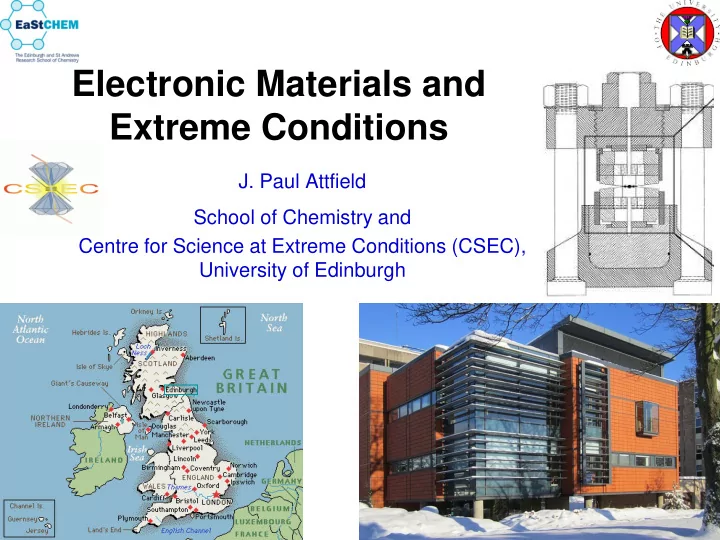

Electronic Materials and Extreme Conditions J. Paul Attfield School of Chemistry and Centre for Science at Extreme Conditions (CSEC), University of Edinburgh
High temperature superconductors (1986-) Superconductivity – correlated motion Compound Tc (K) of electron pairs below a critical temperature (Tc), characterised by Nb3Ge 23 zero electrical resistance and perfect PbMo 6S8 16 diamagnetism; LiTi2O4 13 Ba0.6K0.4BiO3 30 Low-Tc era 1911-1986 HgBa2Ca2Cu3O8+ δ 136 - metals and alloys (ET)2Cu(NCS)2* 13 High-Tc era 1986- Cs 3 C60 34 - copper oxides (etc) Li 0.2 HfNCl 25 MgB 2 39 S S S S * ET = S S
CMR Manganese oxides (1995-) La 0.7 Ca 0.3 MnO 3 - ferromagnetic and conducting Colossal Magnetoresistances (CMR) for sensors, spintronic devices etc. La 0.5 Ca 0.5 MnO 3 - nonmagnetic (antiferromagnetic) and insulating localisation and long range order of; • charges (Mn 3+ /Mn 4+ states), • d-orbitals (Mn 3+ Jahn-Teller distortion) • spins (Mn 3+ /Mn 4+ magnetic moments)
High Pressure Perovskites SrCrO 3 SrCrO 3 PbRuO 3 Orbitally driven phase separation ‘Hard-soft’ Symmetry-reversing orbital transition synthesis SrCrO 2.80 SrCrO 2.75 Arevalo et al ACIE 2012 Ortega San Martin et al, PRL 2007 Kimber et al, PRL 2009 BiNiO 3 (Kyoto) MnVO 3 Colossal NTE Helimagnetic A site spin order Bi 0.95 La 0.05 NiO 3 Azuma et al, Nature Comm. 2011 Markkula et al, PRB 2011
The Verwey Structure of Magnetite (Fe 3 O 4 ) Mark Senn, Jon Wright & JPA, Nature (2012)
Magnetite and magnetism biomagnetism lodestones compass geomagnetism ferrites spintronics
Low temperature properties – the Verwey transition Verwey, E. J. W. (1939). "Electronic • Evidenced by a first order transition in conduction of magnetite (Fe 3 O 4 ) and its resistivity, heat capacity and transition point at low temperatures." Nature 144 : 327-328. magnetisation at 125 K • Complex superstructure Fe 2+ Fe 3+ Fe 3+ [Fe 2.5+ ] 2 O 4 →Fe 3+ [Fe 2+ Fe 3+ ]O 4 Fe 3+ Theoretical approaches: • Verwey (1939) Fe 2+ /Fe 3+ charge order (Verwey model, 1946) • Order-disorder of 2 electron-B 4 tetrahedra (Anderson, 1956) • CO from U/W band instability (Cullen & Callen, 1970) • Polaron (bi-, molecular-) CO (Mott, Chakraverty, Yamada 1970-1980) • Bond-dimerisation (no CO) - Fe 2 5+ dimers (Seo, Khomskii 2002-)
Full structure solution (Senn, Wright, JPA) 2006-2012 Use microcrystals from previous powder (Fe 3-3d O 4 , d < 0.0001 - Prof. J. Honig): • Twinning, multiple scattering, extinction problems reduced by using microcrystallites. • Microcrystal beamline ID11@ESRF - 100 μm focused monochromatic beam. Hard X-rays (74 keV, λ = 0.16653(1) Å) reduces absorption, accesses high Q. • • Magnetic alignment (~1 T field from permanent magnet while cooling through T V ) • Refinement software for twinned crystals (SHELXL) • Try many microcrystals – be lucky h = 50 (hkl) sections Best microcrystal: • approx. spherical, ~40 μm • two twins at 90 K, 89:11 • Cc structure determined using 91,433 unique Bragg intensities • model uniqueness checked against 2,000 randomised starting models Second best microcrystal: • irregular, ~100 μm • four twins • refined structure same as above
Electronic order in the Verwey state of magnetite ….and orbital order Fe 2+ /Fe 3+ charge of Fe 2+ states…. order to first approximation Trimeron order. ….but Fe 2+ ions also Significance? weakly bonded to two •Ground state neighbours – unexpected, not simple trimeron units. charge order. •Prevalence of orbital molecules (trimerons)? •Dynamics above 125K?
Thanks Wei-Tin Chen Lucy Clark Shigeto Hirai Andrea Marcinkova Mikael Markkula George Penny Marek Senn Alex Sinclair Congling Yin Minghui Yang Angel Arevalo-Lopez Anna Kusmartseva Martin Misak Jenny Rodgers
Recommend
More recommend